
Jasmine is a genus of shrubs and vines in the olive family of Oleaceae. It contains around 200 species native to tropical and warm temperate regions of Eurasia, Africa, and Oceania. Jasmines are widely cultivated for the characteristic fragrance of their flowers. Additionally a number of unrelated species of plants or flowers contain the word "jasmine" in their common names.
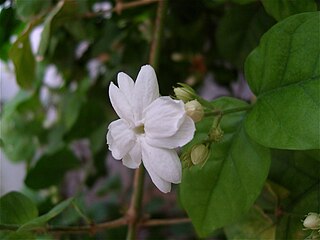
Jasminum sambac is a species of jasmine native to tropical Asia, from the Indian subcontinent to Southeast Asia. It is cultivated in many places, especially West Asia, South Asia and Southeast Asia. It is naturalised in many scattered locales: Mauritius, Madagascar, the Maldives, Christmas Island, Chiapas, Central America, southern Florida, the Bahamas, Cuba, Hispaniola, Jamaica, Puerto Rico, and the Lesser Antilles.

Jasminium dichotomum, the Gold Coast jasmine, is a species of jasmine, in the family Oleaceae. It is an evergreen climber which grows as a rambling shrub or woody vine. The flowers are quite fragrant and open at night, coloured pink when budding then white; these appear at the leaf axils in cluster. It blooms year round. The leaves are opposite. The fleshy fruit is small.

Jasminum grandiflorum, also known variously as the Spanish jasmine, Royal jasmine, Catalan jasmine, Sicilian jasmine, is a species of jasmine native to South Asia, the Arabian peninsula, East and Northeast Africa and the Yunnan and Sichuan regions of China. The species is widely cultivated and is reportedly naturalized in Guinea, the Maldive Islands, Mauritius, Réunion, Java, the Cook Islands, Chiapas, Central America, and the Caribbean.It is closely related to, and sometimes treated as merely a form of, Jasminum officinale. The plant is known as "saman pichcha" or "pichcha" in Sri Lanka.

Jasminum parkeri, the dwarf jasmine, is a species of plant in the family Oleaceae. It is a domed evergreen shrub, growing to about one foot in height, which bears a muddled bunch of small stems with tiny oval leaves. Teeming clusters of fragrant, tiny 5-lobed, yellow tubular flowers, from the axils of the leaves in early summer. Dwarf jasmine is a container plant or trained around topiary form.
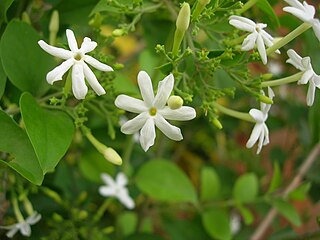
Jasmine is considered the queen of flowers and is called the "Belle of India" or the "Queen of fragrance" as it is exquisitely scented to soothe and refresh. In different parts of India it is called by different names—Mogra, Motia, Chameli, Malli puvvu, Jaati, Mulla, Mallige, Juhi, Mogra or Moonlight in the grove. It is reported that there are 300 varieties of jasmine. It is also stated that jasmine crossed the seas—from Asia to Europe, landing first along the Mediterranean Sea, conquering Greece and Turkey, reaching Western Europe through Spain, then France and Italy and finally landing in England in the latter part of the 17th century..

Jasminum officinale, known as the common jasmine or simply jasmine, is a species of flowering plant in the olive family Oleaceae. It is native to the Caucasus and parts of Asia, also widely naturalized.

Trichilia emetica is a tree in the family Meliaceae, commonly known as the Natal mahogany. It is an evergreen tree, with handsome glossy dark green leaves and a wide spreading crown. Its sweet-scented flowers attract bees and birds.

Tarchonanthus camphoratus, is a shrub or small tree, widespread in Africa south of the Sahel.

Zanthoxylum asiaticum is a species of plant in the family Rutaceae. Under its synonym Toddalia asiatica, it was the only species in the monotypic genus Toddalia, now included in Zanthoxylum. It is known by the English name orange climber.
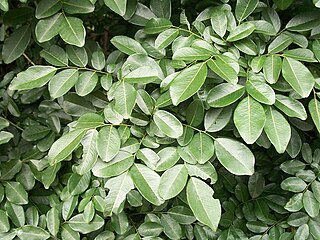
Dalbergia obovata is a robust shrub or climber in the family Fabaceae, and is native to Southern Africa.
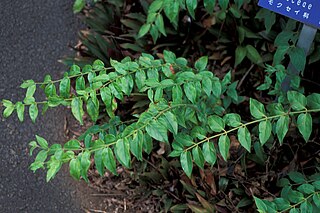
Jasminum multipartitum, the starry wild jasmine, African jasmine, or imfohlafohlane, is a species of jasmine, in the family Oleaceae, that is native to Southern Africa.

Jasminum angulare, the wild jasmine or angular jasmine, is a species of flowering plant in the family Oleaceae that is indigenous to South Africa.

Croton gratissimus, is a tropical African shrub or small tree with corky bark, growing to 8 m and belonging to the family of Euphorbiaceae or spurges. Young twigs are slender and angular and covered in silver and rust-coloured scales.

Pappea capensis is a South African tree in the family Sapindaceae. It is the only species in the genus Pappea.
Acanthopale pubescens is a species of the genus Acanthopale of the family Acanthaceae. The species occurs in East and Southern Africa. Acanthopale pubescensis also known as Herayye in Ethiopia.

Jasminum tortuosum is a species of jasmine native to South Africa. It is generally found twining high into the trees of forests in southwestern part of Cape Province, but also may scramble where there is little vertical space. It has angular branches off its main stem, and its flowers usually have five white petals each. The specific epithet (tortuosum) is from Latin, describing something that is winding or very twisted.
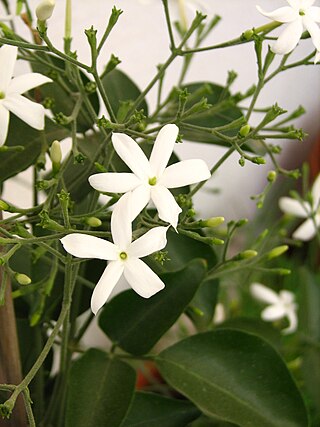
Jasminum azoricum, the lemon-scented jasmine, is a species of flowering plant in the olive family. It is an evergreen twining vine native to the Portuguese island of Madeira. The compound leaves consist of 3 bright green leaflets. The fragrant white star-shaped flowers appear in panicles from the leaf axils in summer, evolving from deep pink buds.

Jasminum angustifolium, the wild jasmine, is a species of jasmine native to Sri Lanka and India, including the Andaman Islands. It is a climbing shrub with a smooth stem and minutely pubescent branchlets. It grows up to 6 m (20 ft) tall. Leaves are dark green and opposite in arrangement. The flowers are approximately 25 mm (1 in) in diameter, and resemble a star with seven or eight narrow petals, flowering between June and August.


















